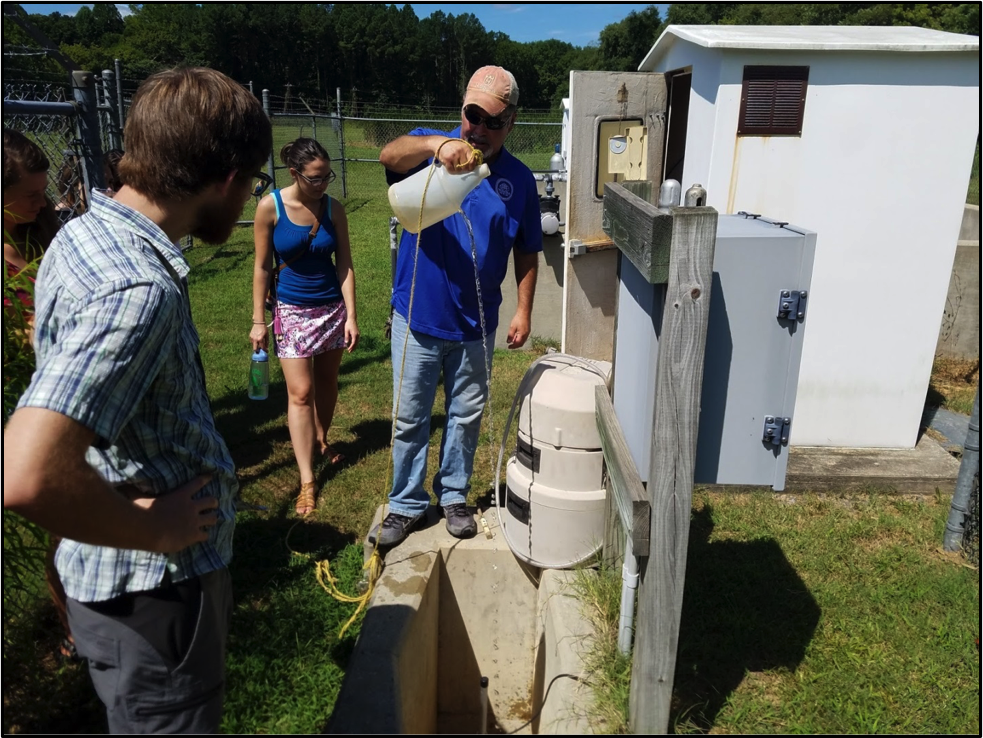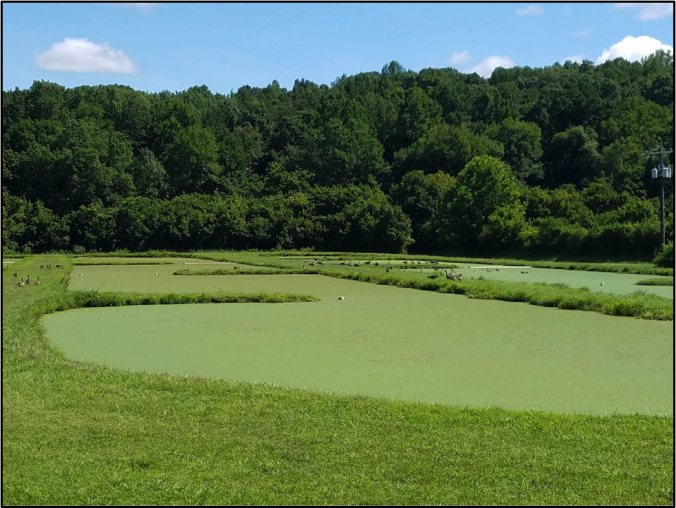by Caitlin Seyfried, Trey Talley, Evan Kirk, and Noel Myers
One hot summer morning, a crew of staff members from the Environmental Finance Center set out on a field trip. We hopped in a School of Government van and eagerly started discussing our destination. As environmentally- and financially-minded individuals, we are interested in water and wastewater services, so it comes as no surprise that we were excited to be visiting a wastewater treatment plant.
However, our destination was not—by any means—a traditional treatment plant. Instead, we went to visit a facility with an innovative, cost-effective, and rather unique approach to handling wastewater: the Walnut Cove wastewater treatment plant.

Walnut Cove, NC
Walnut Cove is a small community of roughly 1,400 residents in Stokes County, North Carolina, just north of Winston-Salem. In 1994, the town had a problem: their wastewater treatment plant was in urgent need of repair. The Board of Commissioners was faced with the significant challenge of figuring out how to pay for a $2 million upgrade to their wastewater treatment infrastructure.
Fortunately for Walnut Cove, Commissioner Wayne Smart proposed an alternative solution inspired by a NASA documentary about the technological requirements of humans living in space. The documentary led Mr. Smart to propose the construction of an artificial wetland treatment system instead of a more expensive, traditional wastewater treatment plant.
The system was installed in 1996 and consists of a series of constructed wetland ponds. Raw sewage is pumped into the first of the primary holding ponds and slowly flows to the second holding pond. Aerators in both ponds ensure oxygen mixes into the water so that the abundant microorganisms thrive and decompose the solid waste, which settles to the bottom. The water is further filtered as it slowly moves through serpentine ponds filled with duckweed. The final pair of ponds are covered in cattails—tall wetland plants that filter nutrients, such as nitrates, from the water. After flowing through the cattail ponds, the water is exposed to chlorine gas (to reduce colonies of fecal coliform bacteria) and then to sulfur dioxide gas (to neutralize the remaining chlorine) in a controlled area before being discharged into Town Fork Creek. It typically takes 60 days, from holding pond to creek, for the input of raw sewage to be transformed into crystal clear water.

Serpentine ponds with a slow, constant flow of water, covered in duckweed during the summer
Not only is the treatment process fascinating and effective, but the facility also hosts a variety of local wildlife on its 20 acres. The open water and green space provide habitat for mammals, amphibians, reptiles, and birds. (The birds are so plentiful that the treatment plant has even attracted Audubon bird-watchers.) During our brief tour of the facility, we saw resident canada geese, muskrats, and turtles, to name a few. A birdwatcher with a keen eye may have been able to spot dozens of songbirds in the trees around the ponds. Plus, despite our fears that we might encounter the typical stench of a wastewater treatment facility, we could barely detect a smell, even during our five minute discussion directly adjacent to the primary holding pond.

Staring into the depths of the raw sewage intake well
Walnut Cove’s constructed wetland wastewater treatment facility is in stark contrast to the traditional wastewater treatment plant that the town had been considering in 1994. The equipment and infrastructure required is relatively simple (ponds, channels, pumps, aerators, and gas cylinders) and the whole operation is low-maintenance. Plant operator and tour guide, Mark Bowman, said that the biggest maintenance expense was mowing and weed-whacking the property so that they can access the ponds and aerators.
Since the Walnut Cove facility requires minimal equipment and maintenance, both construction costs and annual operating and maintenance expenses are markedly lower than those of traditional treatment plants. The initial construction was debt-financed and cost the town around $600,000. The annual maintenance budget is between $20,000 and $25,000. Some major recurring expenses include: (1) purchasing four cylinders of chlorine every three months; (2) replacing pumps at a cost of around $20,000 every three years; and, (3) replacing malfunctioning aerators, which are about $6,000 each and have a useful lifespan of 10 years. Finally, an operator is needed on-site, on average, around 2 hours per day for plant administration.
The maximum capacity of the treatment plant is approximately 500,000 gallons per day, but the plant currently processes about 250,000 gallons per day. Currently the facility processes Walnut Cove residents’ municipal wastewater as well as wastewater brought in by septic tank owners and deposited in the primary holding ponds. The system itself has an indefinite useful life, but will need to be upgraded and expanded at some point. Walnut Cove is currently engaged with researchers at NC State University in search of new ways to further increase the life and effectiveness of the system going forward.
As young people interested in financially sustainable solutions to water and wastewater infrastructure issues, the constructed wetland treatment option offers an exciting alternative for small-scale wastewater management. After 20 years of operation, Walnut Cove’s facility has proven effective, aesthetically pleasing, and relatively inexpensive to operate and maintain. The primary barrier to establishment and construction of artificial wetland treatment facilities is land acquisition and siting, but such challenges are not unfamiliar to local government officials. Creative leasing agreements or financing of land purchases are options for overcoming such obstacles.
While a comprehensive review of other wetland-based treatment facilities is beyond the scope of this blog post, we have included a brief list of other interesting examples for those who would like to learn more:
- John C. Stennis Space Center, MS
- Sidwell Friends School, DC
- Oberlin College Living Machine, OH
- Arcata Marsh & Wildlife Sanctuary, CA
- Urrbrae Wetlands, Australia

Water going back into the local stream. Crystal-clear and purified.
Caitlin Seyfried is a junior Environmental Science major working as research assistant on EFC water and wastewater survey projects. Trey Talley is pursuing a Master’s of City and Regional Planning, and he currently serves as a research assistant for the EFC. Evan Kirk is a recent graduate of UNC and is working at the EFC as a data analyst. Noel Myers is the EFC AmeriCorps Outreach and Education Specialist.






Leave a Reply